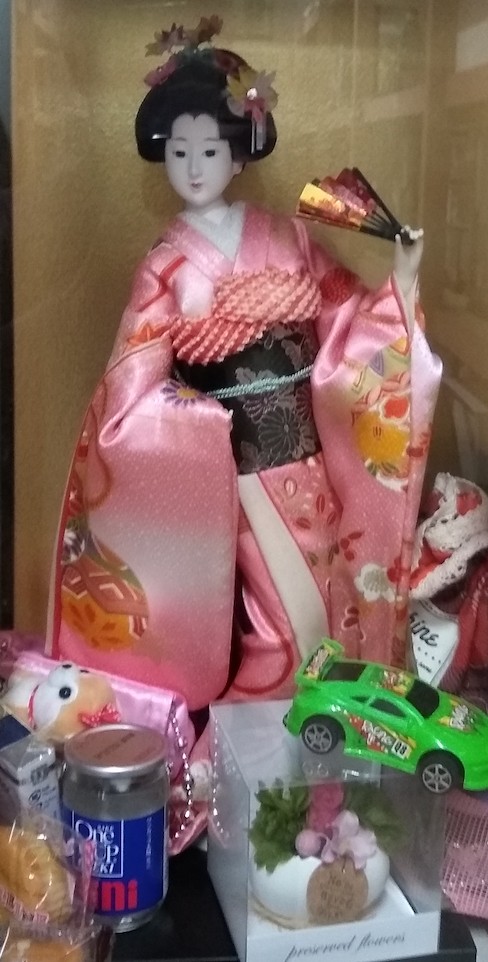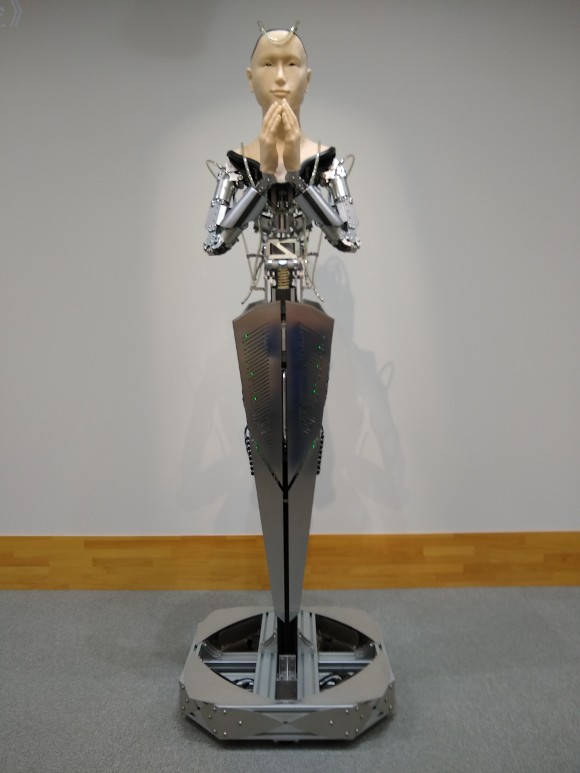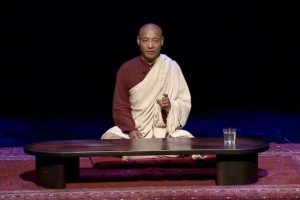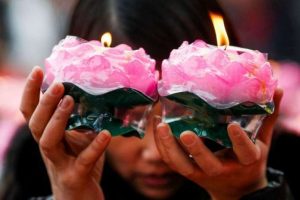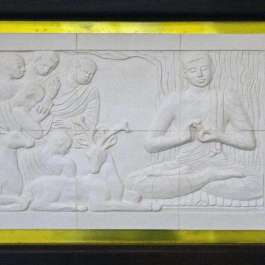I have spent the last two months in Japan, mostly in Tōhoku, the northernmost region of the main island, Honshū. During this time, I was working on a couple of different projects including ghost weddings,* mummies,** and the use of androids in Buddhist temples.*** I have already mentioned each of these three phenomena separately in previous essays for this column. Today, I would like to explore what these three phenomena can teach us about the worldview of Buddhism. I know it sounds bewildering, but these three phenomena share a few deep similarities. The former two express considerations about an afterlife and the notion of immaterial spirits, the latter two assign buddhahood, or at least bodhisattvahood, to seemingly inanimate and insentient beings. And while some, if not all of them, seem to be at odds with Buddhism, all the phenomena that I will talk about here: mukasari ema (pictures of ghost weddings) and hanayome ningyō (doll effigies of ghost brides); sokushinbutsu (the bodies of monks who mummified themselves); and Mindar, an android representation of Kannon (Guanyin) Bodhisattva; are enshrined in Buddhist temples in Japan. What fascinates me about all three of these phenomena is that they reflect specific and interesting considerations about the nature of consciousness and what it means to be human.
Two temples in Tendō City in Yamagata Prefecture, Jakushō-ji and Kurotori Kannon, are famous for their dedication to Kannon Bodhisattva—both are part of the Tōhoku version of the 33-temple pilgrimage in honor of Kannon Bodhisattva—and as temples that enshrine mukasari ema. Risshakuji in Yamadera and Kawakura Sai no Kawara Jizōson (“Jizō Bodhisattva on the bank of the river Sai in Kawakura”) in Aomori Prefecture enshrine hanayome ningyō. In both cases, the spirits of people who have departed without being married are married to a ghost. The temples mentioned here belong to the Sōtō, Tendai, and Shingon schools of Buddhism. So they are a cross-sectarian phenomena.
This year, I further explored the process of making these postmortem wedding pictures and the memorial ritual (kuyō) by means of which they are enshrined in a designated Buddhist temple. The Buddhist temples are not involved in the production of the mukasari ema or hanayome ningyō, but merely perform the memorial rituals and provide a space for these objects of memory and commemoration.

I spoke with one of the few remaining professional artists who paint these postmortem wedding pictures. She said that she communed with the dead and clearly believed in the survival of an immaterial spirit after physical death. To her, humans, ghosts, and gods all possess the same kind of spirit. She believes that these spirits stay in our world after death, move to the other world (the “Pure Land”), and/or are reincarnated. None of these options is permanent. Philosopher Carl Becker of Kyoto University embraces a similar worldview.
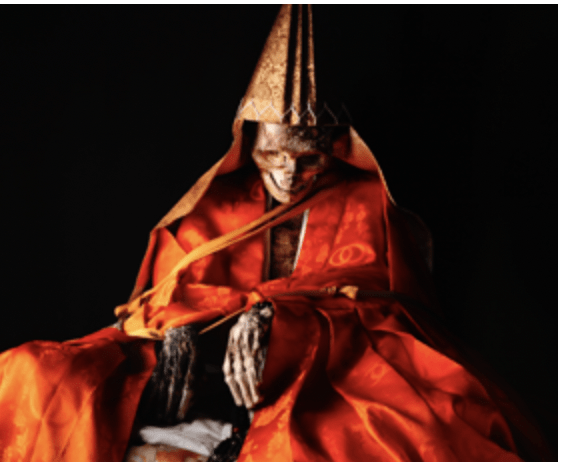
Two other trips took me to the western part of Yamagata Prefecture, where I visited Dainichibō and Nangaku-ji in Tsuruoka City and Kaikō-ji in Sakata City. Each of these temples enshrines one or, in the case of Kaikō-ji, two sokushinbutsu. The documentary Mummies that Made Themselves (available on YouTube) explains the phenomenon and process of self-mummification in some detail. Through hard discipline and a special diet over the course of 3–7 years—mostly in the area of Yūdonosan—a handful of practitioners (shugyōsha) in the Edo period (1603–1868) are said to have cultivated their bodies to such a degree that they did not decompose. The mummies of Tetsumonkai and Shinnyōkai in Chūren-ji and Dainichibō, respectively, allegedly still possess all their internal organs. In my conversations with the head priest of Chūren-ji (in 2016), the temple curator of Kaikō-ji (2019), and the vice priest of Kaikō-ji (2022), I learned about the belief that these mummified monks are not dead per se but continue to cultivate Buddhist practice and have causal efficacy insofar as they can perform miracles. In response to my questions as to whether these mummified practitioners are conscious, I was told that they do not have ego-centric everyday consciousness—my formulation—but rather sit in deep contemplation akin to the so-called bodhicitta (“mind of enlightenment”).
Another set of trips took me to Kōdai-ji in Kyoto, which enshrines Mindar, a representation of Kannon Bodhisattva. According to Mahāyāna Buddhist beliefs, Kannon Bodhisattva can take on any form (see chapter 25 of the Lotus Sūtra) this expression includes androids. Similarly, it can include any sentient or insentient being “having buddha-nature”**** and even “becoming a buddha.” Ven. Gotō Tenshō at Kōdai-ji explained that Mindar is designed to help people overcome suffering and manifests Kannon Bodhisattva. However, Mindar is neither conscious nor able to attain buddhahood. He compared Mindar to a “talking Buddha statue.” In my conversation with him as well as in Mindar’s “Dharma talk,” which he scripted, Ven. Gotō emphasized that while Mindar is “selfless” (muga) and embodies “emptiness” (kū) to some degree, his selflessness and emptiness differs significantly from that of the Buddha insofar as he is unable to experience suffering. Most of all, Mindar constitutes a “skillful means” (hōben).
So what can we learn from these excursions/explorations? What is consciousness? It seems that we human beings are not only “impermanent” (mujōteki), “selfless” (mugateki), and subject to “suffering” (ku) but also not entirely reducible to our bodies. However, more than the answer to this question, my trips and conversations revealed some central insights into how we learn about consciousness. As Evan Thompson has remarked, the study of consciousness is unique in that it features a subject, consciousness, studying itself, consciousness. This unique predicament of consciousness studies creates a fundamental conundrum. It also has important implications for understanding the phenomena discussed in this essay.
If we shake our heads at people who claim that they commune with spirits, are affected by mummies, or assign divinity to androids or other AI, it is because those experiences are subjective and not communicable. The difficulty is that all our positions are formulated from a first-person perspective even as we struggle to achieve a third-person perspective that is universally true. The truth, however, lies somewhere in between, in the relationship between persons and minds, and necessitates a second-person perspective. For some people, this implies a relationship to ghosts, mummies, and/or robots; for me it requires the relationship to and dialogue with people who claim to have had these experiences. As much as I hope it to be true, my position is not a priori superior to those of others but has to be negotiated in a multilogue with numerous positions and minds. Ultimately, this requires, as I have argued elsewhere, a fourth-person perspective.****** This, of course, cannot be worked out in a 1,000-word article or a single-author essay.******* Such a project is best visualized in the Huayan image of Indra’s net. This is what my conversations this summer have taught me.
* Buddhist Death Rituals: For the Living – Not for the Dead (BDG)
** How to Face Death – Pilgrimages and Death Rituals in Japanese Buddhism (BDG)
*** Does Artificial Intelligence Have Buddha-nature (BDG)
**** T 2223.61.0011.
***** T 2299.70.300.
****** Kopf 2021.
******* I have suggested such a method elsewhere (Kopf 2022).
References
Kopf, Gereon. 2021. “How to Make Philosophy of Religion Relevant for the Future,” essay in the series “Is there a Future of the Philosophy of Religion,” published on Philosophy of Religion: big question philosophy for scholars and students hosted by Boston University (https://philosophyofreligion.org/?p=525634#more-525634).
Kopf, Gereon. 2022. “The Theory and Praxis of the Multi-Entry Approach,” in Philosophy of Religion Around the World: A Critical Approach, eds. Nathan Loewen & Agnieszka Rostalska (Bloomsbury Academics).
Taishō shinshū daizōkyō [The Japanese Edition of the Chinese Version of the Buddhist Canon], ed. by Junjirō Takakusu and Kaigyoku Watanabe (Tokyo: Taishō Shinshū Daizōkyō Kankōkai. 1961).
Related features from BDG
What or Who Is a Buddha?
Does Artificial Intelligence have Buddha-nature?
The Problem with Ghosts
Dharma and Artificial Intelligence: Further Considerations
Scaling Intelligence in an AI-dominated Future
Cyberpunk: The Human Condition amid High-tech Alienation and Urban Dystopia
To Keep or Not to Keep? Mortality, Humanity, and Transhumanism
Tangut Twilight: Living Buddhism in the City of Ghosts
Taxing the Robots and Other Externalities
Tocharian Lives and Loves: Haunting Mummies and their Buddhist Descendants




